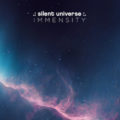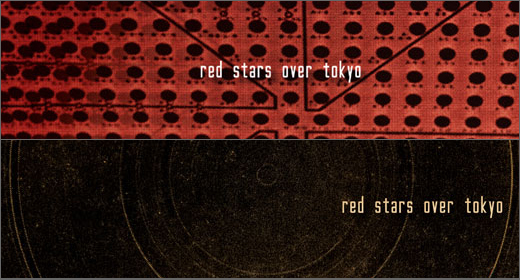Contemporary pieces that reflect the ancient idea of the music of the spheres into the world of contemplative electronica.

Each of the pieces reflect a different mood
This album could have been subtitled Music for Space Organ if I had my druthers. I say that only in the respect that these wonderful and evocative synth pieces, each named after five different stars, remind me of what it might be like to sit in a dimly lit astrobar while sipping a cosmic Mai Tai. In other words, this is galactic lounge music of the ambient electronic variety.
Robin Parmar wrote the music on this album in between work on his many other musical and field recording projects as respite from other work over the course of five years. As such, each of the pieces reflect a different mood, but all are stellar in their composition. Listening allows one to obtain the necessary state of slack needed to recuperate the creative juices between larger works and projects. Another way to hear these is as the mood of each star filtering through the moving fingertips of the artist as he made these aleatoric distillations of their astral essences.
That being said, Parmar did write that he happened to like the names and etymologies of these stars as words, and that’s a good enough reason as any to craft a short electronic album of playful and ebullient moods to help one simmer down.
Let’s go through these contemporary pieces that reflect the ancient idea of the music of the spheres into the world of contemplative electronica.
The first piece is “Belel” and clocks in at 10:40. The star, also known as HD 181342 is in the Sagittarius constellation and has an exoplanet named Dopere that orbits this celestial object. Scientists have aged Belel at 1.56 billion years old and the planet that orbits it has a mass at least two and half times larger than that of Jupiter. “Belel” starts off a bit ominous, but wouldn’t any massive body such as a star also have a bit of dark magisterial gravitas? Then the lighter tones come in, glistening with heavenly wonder.
Perfect for finding a creative work groove ::
The long and sustained tones of “Belel” transform into gentle recursive arpeggiations on “Angetenar” which is just over the eight-minute mark. There is a little bit of feedback or oscillator buzz in the main synth line, with what sound like harp pads or plucked strings warmly resonating underneath. This kind of track is perfect for finding a creative work groove to flow along with, or just to relax into. The star Angetenar was recently renamed Tau2 Eridani in the constellation of Eridanus. This star is visible to the naked eye and is 187 light-years away. The traditional name for this star comes from the Arabic, Al Ḥināyat an-Nahr, which means the “the Bend in the River.” Considering that this album is named “the river of stars,” it is quite appropriate there would be a bend in said river.
For those of us who have been citified for far too long, it can be easy to forget just how much like a river the stars actually are, a flowing stream whose ancient light permeates all our days—and nights. The next track in the sequence is the title piece “Citalá,” which is just over seven minutes long. This song has organ sounds that undulate like a grid placed over the night sky that we now see in parallax. Citalá means “river of stars” in the Nahuatl language and was selected by astronomers from El Salvador. The star is 98 light years away, and 2.6 billion years old with an extrasolar planet orbiting. This planet was given the Nahuatl name Cayahuanca which means “the rock.” This song is the rock that anchors the album, midway between the two tracks on either side.
“Koeia” is another gentle atmosphere to immerse oneself in and is about twelve minutes. It is also located in the constellation of Eridanus, which is represented as a starry river and was one of the 48 constellations of Ptolemy, the second-century astronomer. Eridanus was also a river in Hades in Greek mythology. The darkness of this underworld river does get reflected in these songs, perhaps that makes them dark ambient, but it is the sounds in the depths that vibrate with living light. Burning star cores glimmer with the spark of the divine.
“Achernar” is located at the southern end of the Eridanus constellation as the river flows, and is the name of the fifth and last song in this quintet. This one carries the feel I mentioned at the beginning, of a kind of carnival piece played on a calliope, or celestial organ, and is just under twelve minutes in length. It reminds me of late nights, when after a few too many drinks or puffs, one might wonder up to the top of a hill at a park and lay down in the sweet grass, look up and the stars start to whirl, turning as if on a merry go round. Achernar is one of the ten brightest stars in the night sky and is hot and blue in color due to its strange rotations and velocity. The name Achernar goes back to the Arabic again, which makes sense given their ancient fame as alchemists and astrologers. As the pieces slows down at the end of the album I find myself drifting out, as if in a drunken boat, to swirl and eddy into azure clouds.
Silent Records is the reboot of America’s premier ambient label, founded in 1986 by Kim Cascone. Visit their Bandcamp page.
Citalá, River of Stars is available on Silent. [Bandcamp | Site]



















![Hasbeen :: Bunker Symphonies II (Clean Error) — [concise]](https://igloomag.com/wp/wp-content/uploads/2025/04/hasbeen-bunker-symphonies-ii_feat-75x75.jpg)
![Extrawelt :: AE-13 (Adepta Editions) — [concise]](https://igloomag.com/wp/wp-content/uploads/2025/04/extrawelt-ae-13_v_feat-75x75.jpg)
![Beyond the Black Hole :: Protonic Flux EP (Nebleena) — [concise]](https://igloomag.com/wp/wp-content/uploads/2025/04/beyond-the-black-hole-protonic-flux_feat-75x75.jpg)
![H. Ruine, Mikhail Kireev :: Imagined / Awakenings (Mestnost) — [concise]](https://igloomag.com/wp/wp-content/uploads/2025/04/h-ruine-mikhail-kireev-imagined-awakenings_feat2-75x75.jpg)


![Squaric :: 808 [Remixes] (Diffuse Reality) — [concise]](https://igloomag.com/wp/wp-content/uploads/2025/04/squaric-808-remixes_feat-75x75.jpg)

